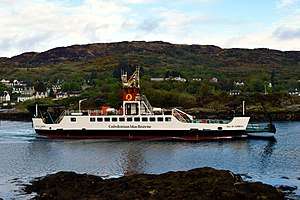MV Isle of Cumbrae
MV Isle of Cumbrae is a Caledonian Maritime Assets Limited ro-ro car ferry, built in 1976 and operated by Caledonian MacBrayne. For ten years she was at Largs and operated the Loch Fyne crossing from 1999 to 2014. She was replaced by the MV Lochinvar in 2014, a new diesel-electric hybrid ferry capable of holding 23 cars and 150 passengers.[4] She returned to Tarbert in 2016 after MV Lochinvar was moved to the Mallaig - Armadale station. She is now the oldest vessel in the Calmac fleet.
 At Tarbert, Loch Fyne, May 2019. | |
| History | |
|---|---|
| Name: |
|
| Namesake: | Isle of Cumbrae |
| Owner: | Caledonian Maritime Assets Limited |
| Operator: | Caledonian MacBrayne |
| Port of registry: | Glasgow |
| Route: |
Tarbert - Portavadie (summer) Relief vessel (winter) |
| Builder: | Ailsa Shipbuilding Company, Troon[1] |
| Yard number: | 551 |
| Launched: | 22 December 1976 |
| In service: | 4 April 1977 |
| Identification: |
|
| General characteristics | |
| Class and type: | ro-ro vehicle ferry |
| Tonnage: | 169 GT; 72 t DWT[3] |
| Length: | 32 m (105.0 ft)[1] |
| Beam: | 10 m (32.8 ft)[1] |
| Draught: | 1.4m |
| Installed power: | 6-cyl Gardner Engines Ltd, Manchester |
| Propulsion: | 2x Voith Schneider Propellers |
| Speed: | 8.5 knots |
| Capacity: | 160 passengers and 18 cars |
| Crew: | 3 |
History
Isle of Cumbrae was built in 1976 by Ailsa Shipbuilding Company of Troon.[5] A crew mess room was added aft of the passenger saloon in early 1994, with the upper deck extended over it.[6] In early 2002, she was re-engined with Scania diesels.[6]
Layout
Isle of Cumbrae's design is a scaled-down version of the Skye ferries MV Kyleakin and MV Lochalsh. She has three lanes on her car deck, with ramps at either end which fold in two sections, like those on the Island Class ferries. Passenger accommodation is down the starboard side, with a small wheelhouse above.[5]
Voith Schneider units at diagonally opposite corners of her hull provide propulsion.[5]
Service
MV Isle of Cumbrae took up the Largs crossing in early April 1977, replacing two small bow-loading ferries, Largs and Coruisk. She remained on this crossing until summer 1986, when the route was taken over by twins MV Loch Striven and MV Loch Linnhe.[5]
In August 1986, Isle of Cumbrae moved to the Fishnish – Lochaline crossing in the Sound of Mull, replacing the small MV Canna. She remained there until July 1997, when she was replaced by the larger MV Loch Alainn.[5] Isle of Cumbrae replaced MV Loch Riddon in the Kyles of Bute, but was herself replaced by the much larger MV Loch Dunvegan in 1999.[5] She then transferred to the summer Tarbert – Portavadie route across Loch Fyne. In winter she took up a relief role, covering MV Loch Dunvegan (Colintraive) and MV Loch Fyne (Lochaline).[5]
In 2014, she was replaced by the diesel-electric hybrid ferry MV Lochinvar, becoming a spare vessel. The 2015 season saw her back at Largs while covering for a broken-down MV Loch Shira and providing additional sailings from Claonaig to Lochranza alongside MV Loch Tarbert during the Brodick Highland Games, before going back to Tarbert and lying spare.
In early 2016, she returned to the Tarbert – Portavadie route after MV Lochinvar moved to the Mallaig - Armadale station.
References
- "MV Isle of Cumbrae". CalMac. Retrieved 25 June 2018.
- "Isle of Cumbrae - IMO: 7521625". Shipspotting. Retrieved 7 September 2018.
- "Isle of Cumbrae". Caledonian MacBrayne. Caledonian MacBrayne. Retrieved 5 December 2019.
- "Build complete on second hybrid ferry - MV LOCHINVAR". Caledonian Maritime Assets Ltd. Retrieved 6 June 2014.
- "Isle of Cumbrae - History". Ships of Calmac. Retrieved 20 December 2009.
- "The dependable 'Cumbrae': a 40th birthday tribute". Clyde River Steamer Club. 9 May 2017. Retrieved 2 July 2018.
External links
- MV Isle of Cumbrae on www.calmac.co.uk